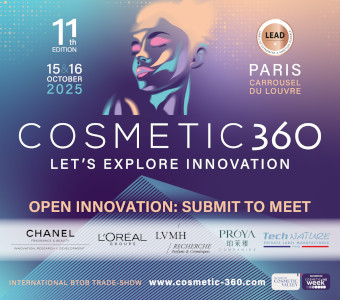Glycation is still drawing a lot of attention because the phenomenon observed on the skin is one of the reasons for skin aging. And staying young, we all know is a quest that seems eternal. The Laboratoires Jeanne Piaubert were among the first to have made an anti glycation claim, with in1996 the launch of the Certitude range. Since then, many players in cosmetics have invested this niche: Chanel, Clarins, Pola, La Roche-Posay and many more. And more are coming... "It’s a theme that reappears in a periodic manner every 3-4 years and on which we are constantly working to offer our customers the latest advances on this issue" agrees Anne Laurie Rodrigues, Communication Manager for BASF Beauty Care Solutions, who has just put on the market the new active Collguard. For Jean-Claude Le Joliff, consultant and founder of the consulting and market-intelligence firm, INN2C, "the advance and constant renewal of tests of objectivation on glycation are the drivers of its renewal."
What is glycation?
Chemically speaking, glycation is the reaction of a sugar, glucose on the amine groups of amino acids constituting proteins. The result is the formation of compounds that lead to by-products named AGEs (Advanced Glycation End products). This reaction is non-enzymatic that is to say, it occurs spontaneously [1]. At the skin level, sugar-based molecules are found in the dermis where are also located collagen and elastin, two proteins that together form the ideal reagents for glycation. Furthermore, glucose in contact with metal ions and oxygen will form aldehydes who also will lead to the formation of AGEs. As a result of these two actions, glycation and oxidation, several types of AGEs are formed. Some, like pentosidine contribute to tissue stiffness by bridging the span between collagen fibres, others are toxins, like glycotoxines, that disrupt the metabolic activity of cells promoting the inflammatory processes, cell death but also an increased production of reactive oxygen species (ROS), the famous free radicals [2]. The result is an aging of the skin with the appearance of wrinkles, age spots and a loss in skin elasticity.

Several approaches are proposed by active ingredient suppliers to combat these signs and recently some novelties have emerged.
Generate competition between molecules
The solution proposed by Exsymol with the range of Silanols (Algisium C®, Argisil C®, Silysin C4®) consists in adding some molecules that will react on protein sites more quickly than glucose. Products that in addition, do not form covalent bonds with proteins and offer a very good bioavailability. Ichimaru Pharcos distributed by Laserson proposes Absorbage, an extract of Plantago asiatica rich in alcanoïdes and Marronnier Liquid b, an extract of Aesculus hippocastanum, which also enters into competition with glucose to limit the glycation reaction. Indena is present in this field with Centevita™ derived from the triterpene rich Centella asiatica.
Preserving glucose
In a different way and to avoid the formation of toxic aldehydes, Lipotec with Dglyage™, a tetrapeptide conveyed in liposomes, targets metal ions by trapping them and thus making them unavailable for the oxidative reaction of glucose. Studies also show a protection of cells DNA. Mibelle with Ameliox a compound of carnosine, silymarin and natural vitamin E inhibits the formation of malondialdehyde thus reducing the glycation process.
The action on collagen
Another strategy developed by active ingredient suppliers is to focus on proteins and in particular collagen that stiffens after glycation leading to the loss of skin elasticity and the appearance of wrinkles. Silab with Antiglyskin®, an active derived from sunflower seeds, rich in phenolic acids and glucopeptides limits the bridging responsible for the stiffening of collagen fibres while also having an anti glycooxydation effect. Lipotec with Vilastène™, protects the lysine fragments of collagen and therefore limits the glycation reaction. BASF with Collguard™, an extract of Davilla Rugosa, a plant found in the Chinese pharmacopoeia preserves collagen through its anti-glycation, anti-radical and anti collagenase properties but also by supporting the synthesis of functional collagen. While, Greentech with Setiline®, an active derived from fenugreek using biotechnology preserves the skin structures by modifying the expression of specific genes involved in glycation phenomena. In parallel the active reduces the keratinocyte differentiation in the epidermis and thus improves the skin barriers.
De-glycation and clearance of glycotoxins
For the approach of glycation to be total, some suppliers have complemented the offer by proposing for Exsymol an active, Alistin® that acts as a protector of glucose and proteins but goes also further in the concept by "de-glycating" molecules helping them to regain their original form. The mechanism is based on a transglycation reaction from glycosylamine, which is the first step in AGEs. This year Exsymol has launched the paraben-free Alistin® P5 and completed its tests of objectivation by demonstrating that the active could also act as a detoxifier of glycotoxines. Ichimaru Pharcos, is also focusing on "de-glycation" with Shakuyaku, an extract from a Chinese plant, Paeonia Albiflora. Sederma with Prodizia™ addresses protein structures damaged by glycation. The active an extract of Albizia or silk tree, supports the cells detoxification systems at the proteasome and glyoxalase level.
Tests of objectivation
Since the first objectivation tests conducted on cell cultures, models have evolved with the addition of additional parameters and the possibility of performing them on skin explants. BIO-EC in partnership with MMP published in 2011 a study on this topic highlighting, on skin explants, the anti glycation activity of substances of plant origin, among which the raw materials offered by the company MMP, with Puerarin 80MM, an extract of Pueraria iobata titrated to 80% of Puérarine and Eucommia Ulmoides leaf extract 80MM, an extract of Eucommia titrated to 80% in chlorogenic acid [3]. "The advantage of the model based on skin explants is to reproduce the skin reactions, we are the closest as possible to an in vivo situation" emphasises Elian Lati, President of BIO-EC. Furthermore, this laboratory is pursuing is investigations in this field by studying the glycation of other proteins and not only of collagen or elastin.
One may therefore come to the conclusion that the new developments around glycation are far from over...



































